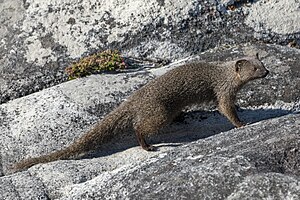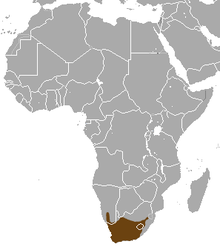Kleinichneumon
| Kleinichneumon | ||||||||||||
|---|---|---|---|---|---|---|---|---|---|---|---|---|

Kleinichneumon ( Galerella pulverulenta ) |
||||||||||||
| Systematics | ||||||||||||
|
||||||||||||
| Scientific name | ||||||||||||
| Galerella pulverulenta | ||||||||||||
| ( Wagner , 1839) |
The Kleinichneumon ( Galerella pulverulenta ), also called Cape mongoose , is a species of predator from the mongoose family (Herpestidae). It is native to southern Africa from South Africa to southern Angola.
features
The Kleinichneumon is a medium-sized species of mongoose with an evenly light and dark gray mottled fur. In the northwest of the distribution area the animals are dark brown-black. The legs are dark brown or almost black. The tail is bushy and is always carried horizontally above the ground. The body length including head and tail is less than 55 to 69 cm, the tail is 20 to 34 cm long and the animal weighs 0.5 to one kilogram. Males grow larger than females.
distribution and habitat
The animals live in the Cape Province , in the southern Orange Free State , in northern Lesotho , along the Drakensberg in western KwaZulu-Natal , as well as in southern and northern Namibia and in southwest Angola . There is a distribution gap in central Namibia, which can also be traced back to insufficient research in the area. The Kleinichneumon is the most common solitary predator in the Cape Province.
It has a large habitat tolerance and occurs in forests, scrub and semi-deserts, in regions with high and low precipitation. It is particularly common in fynbos , on bushy river banks and on densely overgrown mountain slopes.
Way of life
Kleinichneumons are diurnal and are considered solitary. But one suspects a more sociable way of life than previously assumed. They are probably not very territorial, their residential districts overlap. Both sexes mark stones and bushes. They eat carnivore , use their eyes and smell to find food, and choose their prey opportunistically . However, small rodents , especially lamellar tooth rats ( Otomys ) and African welted grass mice ( Rhabdomys ), seem to dominate as prey . In addition, mainly insects are caught. Also of attacks on fawns of old goats and young bush rabbits has been reported.
The Ichneumons utter a short, rattling growl and sneeze or purr when they are caught. The breeding season is from August to December. The one to three young are born between bushes, rubble or in burrows in the ground that the Ichneumons have taken over from other animals. The gestation period of the animals is unknown, as is the age of sexual maturity and the expected age.
Hazardous situation
The International Union for Conservation of Nature IUCN shows the Kleinichneumons in the Red List of Endangered Species as not endangered ("Least Concern").
literature
- Gus Mills & Lex Hes: Mammals of Southern Africa. An illustrated encyclopedia. Könemann, ISBN 3-8290-3610-8
Web links
- Herpestes pulverulentus in the Red List of Threatened Species of the IUCN 2009. Posted by: Hoffmann, M., 2008. Accessed January 26 of 2010.
